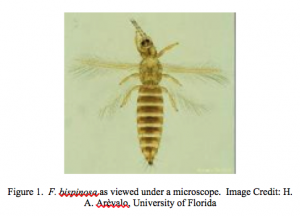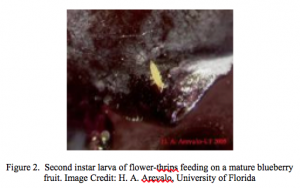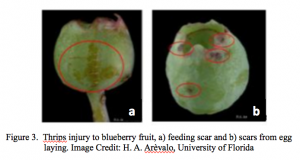Flower thrips are chronic pests of both southern highbush and rabbiteye blueberries in the southeastern United States. Thrips are minute (1 to 1.3 mm long) insects with slender body and usually yellowish to orange in color. Adults have long thin wings fringed with fine hairs (Figure 1). Females are generally larger than males. Both adults and nymphs have rasping and sucking mouthparts, which are used to extract cell sap from plant tissues.
Several species of thrips have been reported to infest blueberries. Of those, the eastern flower thrips, Frankliniella tritici, Florida flower thrips, F. bispinosa (Morgan), and western flower thrips, F. occidentalis (Pergrande) have been identified as pests of both rabbiteye and southern highbush blueberries in the southeastern United States. These three species of thrips have a wide host range and cause extensive damage to blueberries and many different crop plants. Economic damage has often been observed in early-season blueberries.
Flower thrips usually occur in hotspots within a blueberry field. They have relatively short life cycle and can complete development from egg to adult stage in 18-22 days under optimum conditions. Flower thrips go through multiple generations per year. Females lay their eggs within plant tissue, making them very difficult to see with the naked eye. The eggs develop through four larval instars. The first two instars are very active (Figure 2) while the third and fourth instars are inactive. They hide in the ground or in the flowers and do not feed.
Flower thrips usually live inside the blueberry flowers. Both adults and larvae cause damage by sucking sap from flower tissues including styles, ovaries, petals and fruits, reducing the quality and quantity of fruits produced (Figure 3). Flower thrips may feed on pollen, which can lead to fruit abortion. These types of feeding injuries can initiate major yield losses. Additionally, females lay eggs within various flower tissues and the scars from this egg laying activity can cause mature fruit to be unmarketable.
Population densities of flower thrips are highly correlated with the percentage of opened flowers in a blueberry field. Initially flower thrips are observed in hotspots field and the number of flower thrips peak when majority of the flowers (80-90%) are open which is usually 2 weeks from the bloom. The likelihood of flower thrips infestation in a particular field is dependent upon temperature, variety phenology and proximity to alternative host plants.
Monitoring
You can monitor flower thrips in blueberry fields using zip-lock bags.
Zip-lock bag: In this method, collect five bloom clusters from each of the 5-10 randomly selected bushes from different parts of a blueberry field. Place the bloom clusters in a sealed (zip-lock) bag to drive the thrips out of the blooms and count the thrips. If there are 2-6 thrips per bloom, it is becoming problematic and more than 6 thrips per bloom can be quite injurious and therefore control strategies should be implemented.
Management
Flower thrips can be very damaging to flower buds and blooms, especially in rabbiteye cultivars. Thrips numbers often increase dramatically as bloom progresses. Begin sampling bloom clusters for thrips at Stage 3. Sample two to three times a week from Stage 3 up to bloom. Place flower bud clusters in sealed plastic bags and incubate them in a warm room or on a windowsill. Take a minimum of 5 clusters per block each time. Treat if 2 or more thrips per individual bloom are found. Delegate, Entrust, and Assail are effective against thrips and can be used to control thrips. However, these insecticides may be toxic to bees and other pollinators which is a major concern considering the timing of thrips infestations. It is therefore extremely important to use these materials following label instructions in order to minimize unintended harmful effects to non-target organisms. Further details are available in 2017 Southeast Regional Blueberry Integrated Management Guide at https://www.smallfruits.org/SmallFruitsRegGuide/Guides/2017/2017BlueberrySprayGuide.pdf
Reference: Liburd, O. E., H. A. Arévalo, and E. M. Rhodes. 2013. Integrated strategies for controlling flower thrips in southern highbush blueberries. University of Florida IFAS Extension Publication IPM-140.


